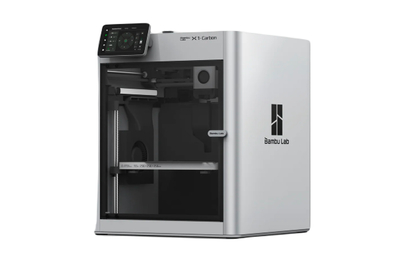Upgrade pick

The big sibling to our top pick, this printer adds an enclosed print space, a tougher nozzle, and other features for printing engineering-grade materials.
The Bambu Lab X1-Carbon doesn’t make faster or higher-quality prints than our top pick, but it does have a larger and enclosed print bed for people who print with specialty plastics such as ABS or those infused with carbon fiber. It also includes reliability upgrades, such as a lidar scanner that works alongside other sensors to automatically level the bed, as well as automated maintenance reminders.
It’s a high-quality, reliable printer. We printed with the Bambu Lab X1-Carbon over the course of six months and found it to be an easy, reliable printer to work with. Its prints, from small tabletop miniatures to larger custom-designed pieces that needed to hold weight, turned out consistently well. The X1-Carbon is also much faster at printing than competitors—twice as fast as the Prusa MK3S+, our previous upgrade pick—yet it maintains the same print quality.
Bambu Lab’s software makes wireless printing easy. Though Bambu Lab has clearly built its slicer using Prusa’s open-source PrusaSlicer, it has added many of its own features. Most important of those is an automatic process for connecting your printer and setting up wireless printing. It’s a delight to see the X1-Carbon automatically connect to the slicer. Other printers, such as the Prusa MK4, require navigating wireless settings and API keys, and cheaper printers don’t have a wireless connection at all, instead requiring a DIY Raspberry Pi print server called OctoPrint for remote or online printing.
In addition, you can manage certain aspects of the printer when you confirm the print job, such as whether you want to perform various calibrations or record a time-lapse. The printer’s included 1080p camera is adequate for monitoring your print.
It automatically calibrates itself. Most 3D printers still require some form of manual calibration, whether that’s setting the z-height of the nozzle or leveling the bed. The X1-Carbon levels its own bed using a lidar sensor and force sensors in the bed, and in our experience this feature resulted in a long series of great prints.
Prints still failed from time to time, naturally, but those were slicing errors where pieces needed more contact with the build plate, rather than errors with the first layer.
It also issues maintenance reminders. We liked that after a few months, we got a pop-up on the X1-Carbon’s screen reminding us to clean the machine’s carbon rods, which the print head uses to glide across the x-axis. A little while later, the printer reminded us to clean the z-axis lead screws.
Each reminder on the X1-Carbon’s screen appeared along with a QR code to scan with a phone; the link showed us how to perform that particular maintenance. The display of these QR codes is the best use we saw of the X1-Carbon’s 5-inch, 720p touchscreen, which you otherwise use for normal printing tasks.
You can order new parts, as long as Bambu Lab sells them. Bambu Lab sells a wide array of replacement parts on its website, but they are parts that only Bambu Lab can make. Bambu Lab also provides detailed instructions and YouTube videos on its website regarding how to install and replace many parts of this 3D printer, a valuable resource for many owners.
Though restricting parts to proprietary designs is a standard business practice in consumer electronics, it’s a departure from the open-source, DIY mentality promoted by many pioneers of 3D printing and to which 3D printing owes much of its current development.
Bambu Lab guarantees years of updates. The company has committed to provide bug fixes and new features for the X1-Carbon until May 2027 and security patches until May 2029. As with the A1 Mini, CEO Ye Tao told us that he expects to support the X1-Carbon beyond those stated dates.
It’s capable of printing with many engineering-grade materials. Whereas the A1 Mini is mainly intended for printing with plastics such as PLA, PETG, and TPU, which are cheap and strong enough for most hobbyist purposes, the X1-Carbon can print with a much wider variety of filament. Its enclosed print space and heat bed, which can reach 150 degrees Celsius, allow it to print with ABS filament, and its direct-drive extruder and hardened-steel nozzle allow for flexible material and carbon-fiber-infused plastics.
It’s fully enclosed. Unlike the A1 Mini, the X1-Carbon is fully enclosed, which helps regulate the temperature of the print area. This makes printing with material such as ABS far easier, since it prevents cooler, ambient air from causing the plastic to curl and warp before it sets fully. The enclosure also reduces the noise of the fans, as well as the clanking noise that the printer makes whenever it cleans the nozzle.
On top of that, the enclosure makes the printer easier to use if you print only once in a while or go weeks or months between bursts of printing activity. Many other 3D printers aren’t enclosed, so they have delicate exposed parts or can get dusty in storage. In testing, we were able to power the X1-Carbon down, put it away, pull it back out after a week or two, plug it in, and run a self-calibration and get back to printing in minutes.
Bambu Lab allows tinkerers to install an alternate operating system. Bambu Lab’s tight software and hardware integration makes it easy for the company to lock down the printer, preventing the use of alternative software. However, the company has recently allowed a one-way path for X1-Carbon owners to gain root access and upload a more customizable operating system called X1Plus, as long as they’re comfortable with voiding their warranty.
This option might be appealing to only a small number of X1-Carbon owners, but it’s emblematic of the company’s willingness to work with third-party developers—and to listen to community backlash—in a way that makes us more confident recommending Bambu Lab printers.
But the company is also locking down its ecosystem. In January 2025, Bambu Lab announced a planned software update that will add a layer of authentication every time an X1 printer takes certain actions, including printing locally over a home network. It will also require owners to run a new application called Bambu Connect alongside the Bambu Studio slicer, or another approved slicer. This also means that third-party developers like OrcaSlicer now have to work directly with Bambu Lab for access to the authentication scheme, which limits the ecosystem of third-party developers to a pool of the company’s choosing. Bambu Lab did not respond to our questions about how these changes will be implemented. We will be actively reviewing whether our recommendation still makes sense as the Bambu Connect software rolls out to the public.

